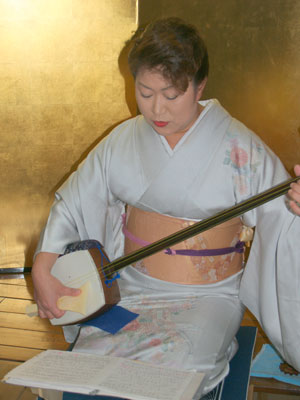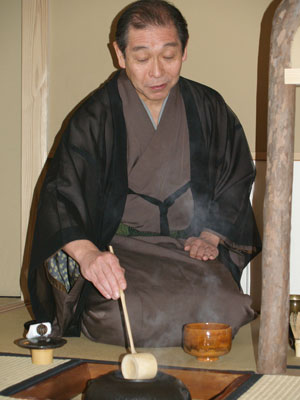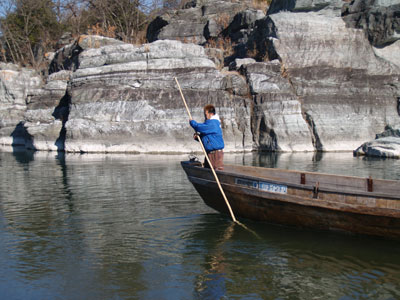An aspiring insider’s tour of Japan
Yvonne Michie Horn, Contributing Editor
Like it or not, as a traveler I’m an outsider. Unfamiliar traditions, off-kilter frames of reference, the constraint of feeling the need to pack in as much as possible in a given length of time — no matter how I long to be an insider, an outsider I’m destined to be.
Even so, by grasping every opportunity to exchange “viewing” for “doing,” I find that it is possible to become a near-insider by trading such guidebook “musts” as traipsing through monuments and cathedrals — which tend to merge into hazy memory — for the searching out of places and hands-on experiences that allow me to step into the everyday of where I am.
I was able to do just that in January ’10 on a trip to Japan sponsored by the Japan National Tourism Organization (New York, NY; 212/757-5640, and Los Angeles, 213/623-1952). It was a visit of but six land days with an itinerary that hopscotched through five prefectures. Nevertheless, the trip packed a treasure trove of opportunities that left me feeling much less a gaijin (literally, “outside person”).
Beginning in Narita
I arrived at Narita airport with the memory of a dreaded, six-hour layover I had had at that airport on a previous visit to Japan. On that trip, rather than spend the time with my nose in a book, I took the escalator to the lower level and hopped on a train to the town of Narita. A few minutes later I was strolling a charming, shop-laden main street that led to 1,000-year-old Shinsho-ji temple, an important center of the Shingon sect in Japan.
Stepping inside the office opposite the temple gates in search of information, I was told that a volunteer guide — in this case, a college student anxious to practice his English — would be happy to show me around. After strolling the temple grounds and gardens, we chatted over a noodle-slurping lunch until my watch warned it was time to hurry back to the airport. Dreaded wait turned into memorable highlight.
On this visit, the itinerary quickly took our group of journalists into Chiba Prefecture. Located on the eastern edge of Tokyo Bay, Chiba is a fertile agricultural area — even in January, when enormous greenhouses shelter acres of strawberries. The berries are grown hydroponically on waist-high platforms, with great care taken to produce fruit identical in size and color. Perfectly matched and incredibly sweet, a box of 20 fetched the equivalent of $20.
However, for a like fee, visitors can eat their way through the plantings, as we did at Ishibashi Farm (e-mail ishibashi@1583ga.com), the only non-Japanese among dozens of grown-ups and children treasure-hunting and plunking luscious berries into their mouths.
Geisha experience
Continuing on through farmland so bountiful that it was known in the Edo period (1603 to 1867) as “Edo’s Pantry,” we entered the town of Kisarazu. Once a great geisha town, Kisarazu was home to numerous ryotei, establishments where accomplished geisha performed stylized dances, sang, played traditional instruments, served sake and provided entertaining conversation. There we visited Kisarazu Geisha, a once-busy geisha training school, where a beautifully garbed geisha greeted us.
Well into her middle years, we learned that when she began training 40 years before, the town boasted more than 200 geisha. Today she is one of but 13.
“Now, not many have the money to give lavish parties,” she explained, adding that what business remains has been taken over by inexpensive “sake girls” wearing Western clothing and adept at pouring sake, no geisha training required.
Seated on the floor at inches-high tables — my bent knees hollering — we were introduced to the ryotei experience of song, dance and the playing of instruments. Then came an opportunity to participate in traditional games. One, the familiar “rock, paper, scissors,” demands that losers spin about while winners pound on a drum — a game that becomes increasingly hilarious, we were told, as more and more cups of sake are downed.
To schedule a visit to Kisarazu Geisha, contact the Kisarazu Tourism Office (e-mail kisa-kan@titan.ocn.ne.jp).
Touring Yokohama
Following an overnight stay at Yokohama’s classy and timeless Hotel New Grand (phone +81 045 681 1841 — room rates, ¥9,500-¥23,000, or $115-$278), with its prime waterfront location and a history that includes the headquartering of General Douglas MacArthur for a short time in Room 315 (now kept as a museum), we traveled on to Kamakura in Kanagawa Prefecture where a plethora of inside opportunities awaited.
The town is chockablock with shrines and temples, some 75 in total. I met up with a volunteer Goodwill Guide, this time a retired gentleman with excellent language skills who understood that, at most, I’d like to visit but one or two. (Visit this site for more information on Goodwill Guides, including a list of cities where they are available.) He suggested a walk along the town’s cherry tree-lined promenade to Tsurugaoka Hachiman-gu shrine.
After demonstrating the purification of hands and mouth at the entrance’s water trough, my guide asked if I’d like to know what my future held.
Joining a line at a counter, in return for a small fee I was given a canister to shake until a single stick emerged. Printing on the stick corresponded somehow to my future, printed out on a small piece of paper — a wishy-washy future, neither good nor bad.
All I had to do, my guide instructed, was tie it on the branches of a nearby tree aflutter with hundreds of others and wishy-washy would blow away.
Together we walked along Komachi-dori, Kamakura’s modest answer to the Ginza, stopping to admire the lacquerwork for which the town is famous and to enter a pickle shop where little dishes offered samples, from squishy to crunchy, of dozens of varieties for sale.
We were on our way to the railway station to catch the Enoden, an electric trolley that began operations in 1902, our destination Daibutsu, a colossus Great Buddha. Weighing in at 93 tons and measuring about 40 feet in height, Daibutsu continues to smile down at the populace, as it has since 1252, despite earthquakes, typhoons and tsunami.
Cultural insights
Returning to downtown Kamakura, my Goodwill Guide delivered me to Kimonoshop Miyamoto, where I bid him good-bye. After admiring the shop’s interior with its lavish displays of sumptuous fabrics for the making of custom-made traditional garb for men and women, I was offered the chance (available by special arrangement only) to partake in sado, or a tea ceremony, presented in the austere style known as wabi-cha.
Taking years of practice, wabi-cha prescribes precise rules that result in seemingly effortless elegance, whether the practitioner is tending the charcoal fire or using such traditional implements as a bamboo scoop to serve the thick, green tea.
Long bus rides took our group from prefecture to prefecture, giving our excellent Japanese guide, Maya Kudo, who traveled with us throughout, opportunities to offer interesting and entertaining insights into Japan’s culture and character.
None of us realized, for example, that though we’d been bobbing up and down like demented yo-yos for a number of days, there was bowing and there was bowing. Bowing is never, ever, Maya told us, a nod of acknowledgment with the head; it is always done from the waist with hands held straight down.
When greeting a passerby, a small bow suffices, with the bow growing deeper when meeting persons of importance or age. The deepest bow of all, bent almost double, is reserved for abject apology.
A traditional stay
We headed for Saitama Prefecture, where we had an overnight stay at a ryokan, a Japanese-style inn.
This would not be my first ryokan experience. On an earlier trip to Japan, I’d stayed in Kyoto at Hiiragiya, in its sixth generation of family ownership and considered one of Japan’s finest. From that visit I understood that one of the purposes of a ryokan stay is to refresh the body and soul. Hiiragiya refreshed with deep tradition and serene elegance, with an extravagant price tag to match (¥30,000-¥90,000, ot $359-$1,078, per person, double).
In Nagatoro, Chosei-kan ryokan (449 Nagatoro, Nagatoro-machi, Chichibu-gun) was far less elegant in service, cuisine and appointments than Hiiragiya, but it had a homey feel ($339 per room, double).
En route to Nagatoro, Maya filled us in on the details of a ryokan stay, from the way a yukata, the provided floor-length cotton robe, should be wrapped — the left side over the right, as the opposite direction, used for wrapping the dead, would not do — to the proper bathing procedure of washing and rinsing before entering the ofuro, the oh-so-hot tub or pool for blissful soaking.
With our arrival in Nagatoro after dark, morning presented the surprise of Chosei-kan’s location, overlooking a rocky canyon through which the Arakawa River flows.
Although it was January, with ice forming on the water’s edges and icicles hanging from the banks, we embarked on a river float in open wooden boats propelled by pole men stationed fore and aft. Cozy we were, however, by pulling up to our chins a quilt-like affair thrown over a table that ran down the center of the boat under which an enclosed charcoal brazier blazed.
The river floats are operated by Chichibu Tetsudo Railway from March through December. The 60-minute trip costs $37 per person ($18.50 for 30 minutes) and can be arranged through Chosei-kan.
Noodles and knives
Leaving Nagatoro, we stopped outside Chichibu for lunch at Komatsuzawa Leisure Farm (1408 Yokose, Yokosemachi Daiji; fax 0494 24 4534), a working farm offering out-in-the-countryside experiences to city dwellers. There we found ourselves in the farm’s large kitchen elbow deep in buckwheat flour, with the goal of creating the soba noodles that would be our lunch.
Helpers demonstrated rolling techniques and the chop-chop-chop of a razor-sharp knife that results in noodles paper thin, a process easier watched than accomplished.
En route to Chichibu, we’d learned from our guide that noisy slurping of noodles is considered good manners. And so we complied, holding chopsticks in one hand, cup in the other, pursing our mouths and sucking in. The experience, including lunch, costs $50 per person.
I had an opportunity to buy one of those sharp-as-a-razor knives later on that day in the town of Kawagoe, affectionately known as “Little Edo” by the Japanese tourists who pack the town on weekends and holidays. On the main street was a shop housed in an architectural treasure, a centuries-old merchant house. It contained nothing but knives — hundreds, maybe thousands, of knives of countless persuasions.
Trying one out on an apple placed on the counter for demonstration purposes, I was told to let the knife glide without pressure. Voila! The apple was in half, just like that! With visions of perfectly sliced soba noodles I’d make at home, I was sold.
Tokyo highlights
Driving into Tokyo at night via expressway took my breath away. A compelling kaleidoscope of colored lights stretched for miles, outlining buildings of varying heights seemingly piled one on the other, with Tokyo Tower, taller than the Eiffel Tower after which it was patterned, brilliantly punctuating the sky.
We later learned that in 2012 the lovely broadcasting tower will take second place on the landscape to the Tokyo Sky Tree, which, at 2,080 feet, will be one of the tallest man-made structures in the world.
We had a second fabulous view of Tokyo at night aboard a yakatabune, one of the old-fashioned houseboats that operate year-round on the Tokyo waterfront (average cost, $125 per person).
Dating back to the Heian period (794-1185), yakatabune were luxuries afforded only to the privileged. It was not until the Edo period that they became accessible to the commoner. Today, the little boats decked out in lanterns are a beloved tradition among true-blue Tokyoites.
Seated at low tables, blessedly with space cut out below for our legs, we enjoyed course after course of impeccable sashimi and crunchy vegetable tempura, washed down with plentiful sake as the glorious skyline passed by. And how does one end an evening on one of today’s yakatabune? Karaoke, of course! Visit www.harumiya.co.jp for more information.
Sumo stops
Next was a visit to Ryōgoku Kokugikan, the stadium for sumo wrestling. Along with baseball, sumo counts as Japan’s most popular spectator sport and dates back to the eighth century. In the heady, decadent days of the Edo period, there was women’s sumo as well.
At a small stadium museum, one may pick up a handbook and take a self-guided walk of the neighborhood, which houses several sumo stables (training establishments).
A food staple at the training stables is chakonabe, a healthy and filling hot pot of chicken, vegetables and broth. Popular places to eat in the neighborhood are restaurants, owned by former sumo stars, that feature chakonabe, albeit in manageable quantities.
Along the way, we stopped off at Lion-Do, which stocks everyday clothing for wrestlers. The owner held up boxer shorts the size of a small tent. I admired a sport shirt made of camouflage-printed material that, if you passed someone wearing it on the street, would make you feel like you were strolling past a jungle.
After six all-too-fast, hopscotching days that nevertheless managed to offer up a bounty of only-in-Japan experiences, did I still feel like a gaijin? Of course not. An insider? Almost.





